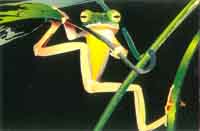Usually, frogs lay their eggs in a suitable habitat and the eggs are left to hatch and develop by themselves. There are some species that have developed "nests" to afford the eggs more protection. The tree frogs of the family Rhacophoridae are one such group.
They are foam nest builders. The male uses his hind legs to whip up the albumen extruded with the eggs into a thick froth. The whole frothy mass ( with the eggs within it) is suspended from a tree or bush above a suitable body of water, into which the tadpoles
will drop when hatched.
The eggs inside the nest are kept moist as the foam nest dries, forming a crust on the outside that is resistant to water loss. The eggs hatch within the nest; the nest liquefies from within as the tadpoles develop and the crust is broken by the liquid mass
at about the time the tadpoles are ready to take to water.
 Tree frogs are widely distributed in India. However a high diversity of species is found only in the wet or hilly areas. The most spectacular member of this family is the Malabar Flying Frog ( Rhacophorus malabaricus) found in the deciduous and evergreen
forests of Kerala, Tamil Nadu and Karnataka. The frog is bright green above with golden yellow sides. Has bright crimson colored webs on fingers and toes. This frog has long toes, all of which are fully webbed. It leaps from trees and extends its fingers and
toes; this action creates a parachute effect at each limb extremity, and allows the frog to glide to another tree.
Tree frogs are widely distributed in India. However a high diversity of species is found only in the wet or hilly areas. The most spectacular member of this family is the Malabar Flying Frog ( Rhacophorus malabaricus) found in the deciduous and evergreen
forests of Kerala, Tamil Nadu and Karnataka. The frog is bright green above with golden yellow sides. Has bright crimson colored webs on fingers and toes. This frog has long toes, all of which are fully webbed. It leaps from trees and extends its fingers and
toes; this action creates a parachute effect at each limb extremity, and allows the frog to glide to another tree.